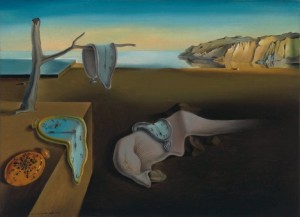By Kelsey Gray
The start of a new year often brings both reflection and anticipation. We think about how we spent our time in the past and how we would like to spend our time in the future. We spend time thinking about time, but what do we know about the nature of time itself?
In 1922, ninety-five years ago, physicist Albert Einstein and philosopher Henri Bergson had a conversation that forever changed the human understanding of time. Their discussion examined time from two different perspectives: physical and psychological. Physical time exists regardless of the presence of people and can be measured by clocks. Psychological time is subjective and relates to the way people experience time.
We can learn about physical time using physics and math. Discoveries made in physics during the twentieth century, especially Einstein’s theory of relativity, drastically altered the way people understood time. There are two main rules in special relativity:
1) The laws of physics are the same for everything that is not moving relative to one another.
2) The speed of light in a vacuum is always the same.
These two rules allow us to explain a phenomenon known as the “Twin Paradox,” which states that if one twin were to stay on earth while the other twin traveled on a rocket near the speed of light into space and then turned around and came back to earth, the twin who traveled out to space would be younger than the twin who stayed on earth. Amazingly, several experiments have provided evidence to support this theory! Einstein’s theory of relativity also provides us with practical technologies that we use everyday.
We are able to use technologies like GPS navigation thanks to relativity. It is important for time-sensitive technology, such as GPS navigation, to have a highly accurate way to measure time. This exactness can be accomplished by using atomic clocks. These handy timekeepers measure time so carefully that they are only off by one second every 100 millions years! Atomic clocks keep track of time using the movement of an atom. Specifically, they define one second as the amount of time it takes a Cesium atom to move back and forth 9,192,631,770 times.

The Persistence of Memory by Salvador Dali
Thinking back to the physical and psychological perspectives of time, we can see the theory of relativity and the atomic clock only account for one of these ideas. Although time can be measured in a precise manner, we sometimes feel that the same amount of time is longer when we are bored or flies when we are having a blast. People can experience differences in psychological time as a result of both their age and their memories. Hannah Arendt wrote about proportionality theory, saying, “The lived experience of the length of a year changes radically throughout our life. A year that to a five-year-old constitutes a full fifth of his existence must seem much longer than when it will constitute a mere twentieth or thirtieth of his time on earth. ”
Another way that we experience the same amount of time as shorter or longer than it truly is involves the storage of memories. Perhaps when we create more memories in a given period of time it appears to be longer and fuller of activity, thoughts, and emotions. How frequently we think about those memories may also affect how long ago we think the event in the memory occurred.
The nature of time presents a unique opportunity to ponder and study the intersection of physics and psychology. While physics is important for describing time objectively, the psychology of time is important for understanding the way we use our time each day. In the words of Hannah Arendt, “It is the insertion of man … that transforms the continuously flowing stream of sheer change into time as we know it.”
Edited by Tamara Vital and Christina Marvin
